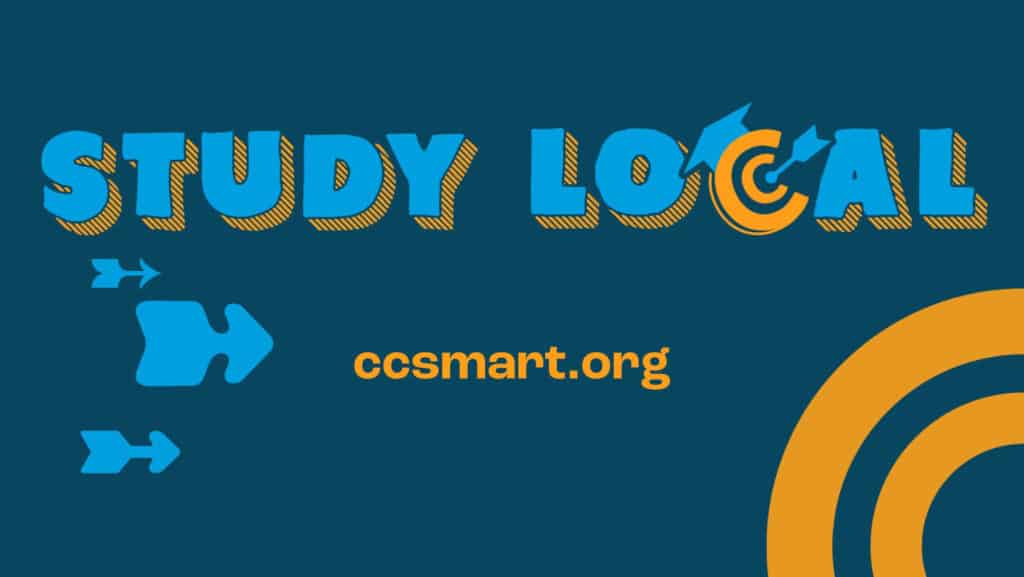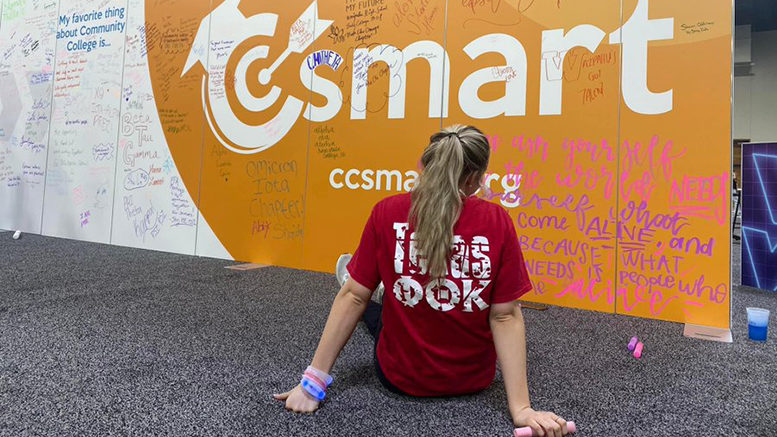Declines in community college enrollment mean declines in a properly trained workforce, not to mention an even greater gap between demographic groups that traditionally have availed themselves of higher education and those who are underrepresented.
And while cost often comes up first in mulling the barriers to college access — which include other factors like academic achievement, personal aspirations and the influence of family — the image problem two-year colleges face with some in the general public also figures into the mix.
Enter the Community College Smart (CCsmart) program, launched by the national student leadership team of the Jackson, Mississippi-based Phi Theta Kappa Honor Society. Designed to spotlight the opportunities available at two-year colleges, and lifting up what community college has done for them, the goal is to promote student-led advocacy — and change the conversation about the colleges.
PTK infused the concept into its five-year strategic plan for 2022-27. The organization’s board subsequently approved money for a pilot project to fund a mass media campaign in three states, says Lynn Tincher-Ladner, CEO of Phi Theta Kappa (PTK) and a member of the American Association of Community Colleges (AACC) board of directors (PTK is an AACC affiliate council).
“Phi Theta Kappa is uniquely positioned to tackle this problem and communicate with the public at large,” she says of the century-old organization, which has more than 3.75 million members and nearly 1,300 chapters in 11 countries and is recognized as the official honor society for associate-degree granting institutions.
Drafting a plan
The media campaign began rolling out in Wyoming, Iowa and Louisiana in late summer. Aimed at high school students and their parents, as well as young adults not enrolled in college, the campaign comprises a website and social media with written messaging, photos and videos extolling the virtues of community colleges.

A 2021 study of Illinois high school seniors conducted by Bradley Griffith at the University of Arkansas found that, at a surface level, students and the public at large consistently think highly of community colleges. But when the study dug deeper, Tincher-Ladner says, the research found many students thought “community colleges are great for you, but not for me.”
“That is a tough nut to crack,” she says. “We looked at research on advocacy re-norming campaigns, like how long did it take to get people to stop smoking? The research says you have to run mass media for at least six months. We have money to run it for four months in three states.”
PTK is also encouraging chapters to reach into their respective communities to make presentations to high school students and younger adults who might be receptive to messages about the “workforce development end of things,” Tincher-Ladner says. “The other part of the advocacy piece is, who are the strategic partners for something like CCsmart?” she says. “I would consider AACC a strategic partner.” Others could include the National College Attainment Network.
“There’s a whole advocacy piece that starts with the students, of course, but there are other pieces to this that we’re working on,” she says.
State-by-state rollouts
As the leader of one of Wyoming’s eight community colleges, the state’s representative on the PTK president’s advisory board, and the current AACC board chair, Joe Schaffer, president of Laramie County Community College, is enthusiastic about what he describes as “the campaign to promote community colleges as the first choice, as the smart choice for postsecondary education, and what to do to improve (a student’s) life.”
As a state with abundant natural resources — and the resulting plethora of middle-class jobs that typically don’t require postsecondary education — Wyoming has only recently focused on the need to boost the talent and education level of its citizenry, due to a combination of changing technology, economic volatility and resulting economic diversification, Schaffer says.
“We’re trying to use language and media to reshape the norms of our culture, from thinking that community colleges are the second choice, the backup choice, ‘good for my neighbors,’ to making them be seen as the first choice for a smart investment in your future,” he says. “We’re building out collateral, working with other institutions to integrate CCsmart materials into our marketing campaigns.”
Community colleges are partnering with their respective PTK chapters to ramp up efforts to engage students in the messaging, Schaffer says.
“We’re trying to get substantial movement on the pilots this year and get other colleges engaged,” he says. “We’re asking colleges to sign on and use the material developed in the social media.”
In addition to breaking the historical perception of community colleges as a second choice, or a convenient choice, the effort aims to show prospective students what’s available in terms of scholarships and other aid, and how community colleges can serve as a path to a baccalaureate, Schaeffer says.
“Many students are first generation and don’t understand what the actual net cost of attendance is,” he says. “They don’t understand how to access financial aid. They don’t understand how powerful a transfer engine we are. … Certainly, I hope we have more people pursuing a postsecondary credential, whether first-time or for retraining. Ultimately, that means greater productivity in the talent pipeline, leaving higher education with the knowledge skills and credentials that will align with where we’re going from an economic perspective.”
Advocating collectively
Emily Shields, executive director of Community Colleges for Iowa, holds similar hopes for the 15 colleges in her state, which have faced enrollment challenges like in other states.
“There is a greater need to not only advocate and market individually but advocate collectively,” she says. “We want to knock down barriers. The idea that it’s ‘less than,’ we want to knock that down. We can say, ‘Here’s an option that’s more affordable, [and] likely more closely aligned with a career where you are.’ The benefits are more clearly linked. The goal is to help people think about community college differently, so they investigate their local community college and see what programs might be a benefit for them.”
The CCsmart website serves as a terrific clearinghouse of information, Shields says, and both her association and individual colleges in the state have been posting on social media.
“We’re hoping to see some traction. If we see that collaborative marketing can be successful, it gives us a path forward to think about other options,” she says.
As the pilot begins, the association and individual colleges’ presidents and marketing directors will analyze data to see what’s working and what isn’t, hopefully securing more funding, and thinking about how the effort could spur those potential further partnerships across the state, Shields says.
“We don’t want to think about marketing a public institution,” she says. “But the reality is, we’re up against private, nonprofit institutions with significant marketing budgets. We have to invest in this for students to know their options. We know [social media] is where a lot of this generation is getting their information. If we’re not in that space aggressively, they lose out, and so do we.”
Reset the discussion
Monty Sullivan, president of the Louisiana Community and Technical College System, says the fact that community college leaders have gone through university education themselves often leads them to think that their colleges ought to be built in the image of a university.
“The mission of a community college is dramatically different from a research university, or a regional university,” he says. “We need to reset the discussion away from a comparative discussion, to one that points out the innate positives of community colleges. It’s one of the reasons we got excited about this, and it’s why our students are voting with their feet every day, attending degree programs and certificate programs at community colleges.”
Louisiana plans to roll out CCsmart in sync with four colleges starting in early October and add four each month until all 12 are involved, Sullivan says, noting that while enrollment in the state plummeted by about one-third between fall 2019 and fall 2021, he’s heartened to see that the fall 2022 number has rebounded to where it’s only down 4% from three years ago.
“We’re trying to cause people to pause for a second and realize that this mission is uniquely American,” he says. “We are democracy’s college. We’re not ‘as good as’ the universities — we are absolutely different from the universities. … Our goal is to begin to see that change, so people describe the community college experience for what it is: a very positive outcome for students going into the workforce.”
Sullivan anticipates that the message of CCsmart will build over time and across the nation.
“We have three states in the beginning, and I know Phi Theta Kappa intends to have this movement become much larger,” he says. “We’re glad to become one of the first three states involved. How often do you see not-for-profit student organizations step up with their own money and tell their story? That’s leadership, and it’s extremely valuable for all of us.”
How to get involved
Although only Wyoming, Iowa and Louisiana will be part of the mass media campaign, Tincher-Ladner hopes that community colleges from coast-to-coast will participate in any way they can, and she anticipates that hundreds of PTK chapters will do the same. Colleges and other entities looking to get involved should start by signing up on the “Take Action” page of the website.
“What does it mean to be a CCsmart institution?” she asks. “It’s not just marketing. You have to change the mindset of the public. It’s going to be advocacy. It’s going to be making sure colleges have the academic experiences you say [students] are going to get. It’s about the colleges continuing their work to be excellent and equity-minded institutions. It’s all the things they’re working on through AACC.”
Upcoming presentations about CCsmart will take place at the Rural Community College Alliance annual meeting in Iowa this month, the Association of Community College Trustees annual Leadership Congress in October, and the PTK Regional Officer Institute in November.
The concept was certainly a hit when Tincher-Ladner introduced it to students at PTK’s last convention.
“What’s important is that CCsmart is not about working so much with current community college leaders,” she says. “It’s about going out and talking to the public. People are used to Phi Theta Kappa talking internally; this is an evolutionary step for our organization’s advocacy for community colleges. We want to leverage that group of students to bring our stories to the public about how great community colleges are.”

